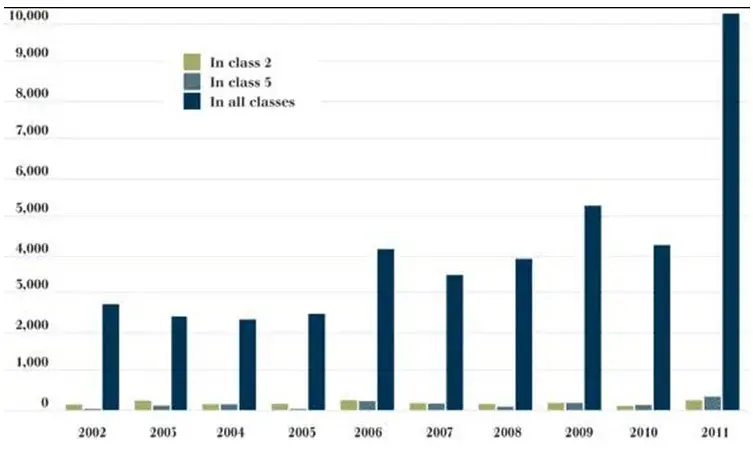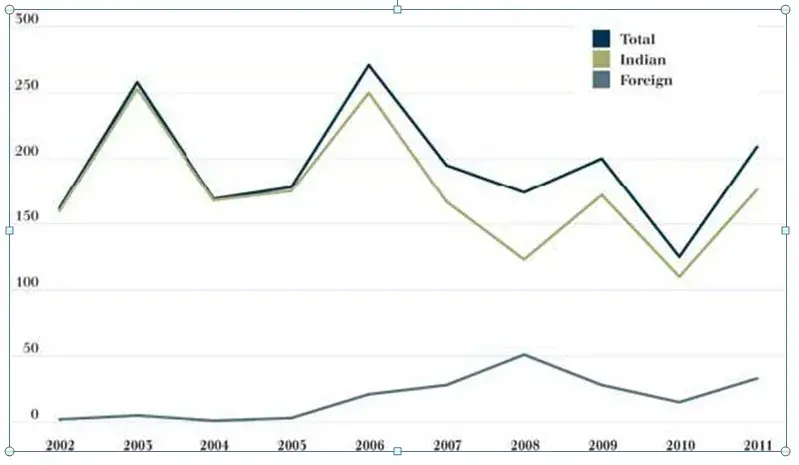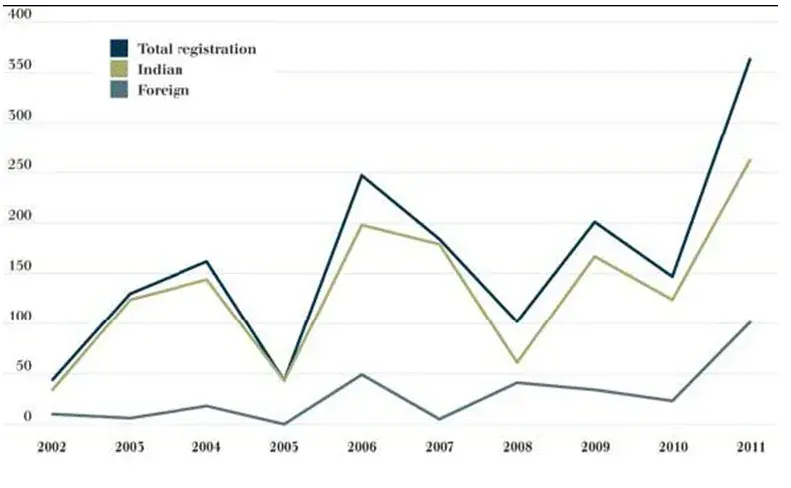Rishu Srivastava and Vikrant Rana of SS Rana & Co assess the role of IP regulations in India’s increasingly influential textile industry
The prominence of fashion in our image conscious world, and the socially imperative and accepted flamboyant culture it has created makes it an indispensible aspect of today’s modern life. With the inception and advent of globalisation the textile industry has apparently moved from a mere product to a well characterised and categorised brand. As an integral component of world trade, the fashion industry thrives on huge investments and constant improvement and innovation. These original creative expressions and the intellectual capital are not only the drivers of competitive advantage but also are the fountainheads of invaluable IP assets in the apparel and textile industry. It is thus vital for all business entities to identify and protect their intangible assets to prevent their unauthorised appropriations.
Why register a design?
The function of apparel has graduated from a social, cultural and utilitarian role, to aesthetics and expressions of art. Design has become a bulwark of any successful marketable entity and besides the functionality , it is the luxurious aesthetic feature of apparel that has championed a brand and determines commercial success of the product. The very fact that the clothing industry invests huge sums to come up with new and original designs each season makes design registration as integral a part of the fashion industry as it is of any other business venture. It is more than required in the fashion world as blatant infringement of novel creations are often defended on the grounds of homage, inspiration and dedication. It is the IP rights that recognize and harness individual creativity and unless the incentive of monopoly right is guaranteed, the designers can neither be stimulated to create nor can they actually be rewarded for their creation.

Graph 1: Designs in class 2 (articles of clothing and haberdashery) and class 5 (textile piece goods, artificial and natural sheet material)
Design or copyright?
The protection accorded by copyright and designs are overlapping in nature and their interaction have been discussed in several disputes, including the much debated Rajesh Masrani vs Tahiliani Design and Microfibres vs Girdhar and Co. While the articles falling under the purview of artistic work and design are clearly delineated in The Copyright Act, 1957 and in the Design Act, 2000, it is Section 15 of The Copyright Act that needs to be mentioned here. That section provides for special provisions stating that copyright shall not subsist in any design which is registered or capable of being registered under The Design Act. Another important parameter of this provision is that copyright in the design shall cease as soon as any article to which the design has been applied has been reproduced more than fifty times by an industrial process by the owner of the copyright or with his licence by any other person. This clause stymies the inherent protection accorded by copyright that a person enjoys merely by virtue of creation. However it is the same clause that was used to its advantage by Tahiliani Design in the famous Rajesh Masrani vs Tahiliani Design case where the latter succeeded in getting an injunction on the ground that the subject matter of the suit belonged to the couture line and not more than twenty or possibly fewer copies were made of any single costume. Though the case may lead to fewer designers actually filing designs, it should be remembered that in order to claim damages it is essential to get the design registered. The Tahiliani brand itself stands among the top filers in the country (in class 02-02) having filed more than 40 designs in the last 10 years.
Nevertheless, the aforesaid section tends to distinguish purely artistic works and work that has commercial overtones. It was also clarified in the Microfibres vs Girdhar and Co, where the judge stated that “what cannot be lost sight of is the very object with which such arrangements or works had been made. The object is to put them to industrial use. An industrial process has to be done to apply the work or configuration to the textile. It is not something which has to be framed and put on the wall or would have any utility by itself. The two important aspects are the object with which it is made (which is industrial) and its inability to stand by itself as a piece of art”.
A failure to register a creation capable of being registered as a design may result in loss of both copyright and design. Furthermore, it can be interpreted that while the artistic work of the apparel, textile and fabric including prints, arrangement of patterns and design are copyrightable material, the haute-couture and custom-designed apparel is to be registered under The Design Act. Moreover, in the case of infringement proceedings, little respite is offered by copyright.
Table 1: Top registrants in class 02-02 (for garments)
| S. No | Registrant | Number of registered designs |
| 1 | Tahiliani Design | 47 |
| 2 | Charming Apparels (P) |
27 |
| 3 | Radhika Naik Couture | 17 |
| 4 | National Institute of Design | 14 |
| 5 | Swastika Garments | 14 |
| 6 | Mahotsav Creation | 13 |
Source: Patent and Design Journals

Graph 2: Total designs in class 2 compared with Indian and foreign designs in class 2
It is the design rights that provide for much stronger protection. Section 22 of The Design Act states that in the case of piracy of a registered design, the infringer shall be liable to pay the registered proprietor of the design a sum not exceeding Rs25,000 ($451) recoverable as a contract debt; if the proprietor elects to bring a suit for the recovery of damages for any contravention of the rights conferred to him and for an injunction against repetition of it, damages may be awarded and the person may be restrained by injunction.
Registration under The Design Act
The preliminary condition for the registration of a design is its novelty and originality. The design should also be significantly distinguishable from known designs or their combination, and should not comprise scandalous or obscene matter. The protection extends to features of shape, configuration, pattern, ornament, composition of lines or colour, and is given for a period of 10 years which can further be renewed to another five years. The third schedule of the Design Act provides for registration of articles of clothing and haberdashery in class 2 and textile piece goods, artificial and natural sheet material in class 5.
The design registration system in India is time bound and the fastest of all IP registration procedures. Moreover, in view of the resources invested in creating a new design, the registration procedure is economical and cost effective. Once registered the proprietor enjoys monopoly and exclusive rights not only against copies of the protected design, but also against substantially similar products.
Textile industry and trends
The magnanimous presence of the Indian textile industry and the fundamental role it plays in the country’s economy, can be deciphered from statistics showing that not only does it provide for the basic necessities of life, but also contributes about 14% to industrial output, 4% to the GDP, 17% to the export earnings and accounts for nearly 12% share of the country’s total exports basket. As per the study conducted by Assocham, one of India’s apex trade associations, the Indian designer wear market is growing at a compounded annual growth rate (CAGR) of about 40%. India’s share in the global designer wear industry is a minimal 0.32% but is likely to reach about 1.7% by 2020.
Table 2: Top registrants in class 05-05 [for textile fabrics]
| S. No | Registrant | Number of registered designs |
| 1 | Genesis Colors | 276 |
| 2 | Parry Murray & Co | 201 |
| 3 | Biba Apparels | 153 |
| 4 | The Rishadsfadffdsf Velveleen | 140 |
| 5 | fdsfdsfsdfsfsdf | 40 |
Source: Patent and Design Journals
India’s textiles products, including handlooms and handicrafts, are exported to more than a hundred countries. The association of textile industry with agriculture and the ancient culture in India, along with the country’s traditions, make the Indian textiles sector unique in comparison with the textiles industry of other countries. It has the capacity to produce a variety of products suitable for the different market segments, both within and outside the country. It provides direct employment to over 35 million people in India, making it the second largest provider of employment after agriculture. In the global market exports of clothing, India ranked as the sixth largest exporter and in the global exports of textiles, India ranked as the third largest exporter, trailing only the EU and China (as per 2010 WTO data).
These promising figures are, however, belittled when compared with the number of design registrations in the textile sector in last 10 years. Of the approximately 41323 design registrations since 2002 only 2001 designs are registered in class 2 (4.8% of the registered designs). It is pertinent to mention here that of these 2001 designs only 218 are registered under garments (class 02-02). The maximum design (1562) in this class is registered under the category of footwear, socks and stockings. With over 45 registrations in the category of garments Tahilani Design is probably the only fashion entity which is among the top filers in the country.
Similarly in class 5, 1623 designs have been registered so far making only 3.92% of the total registered designs. Here again only 1506 designs pertain to textile fabrics (class 05-05).
It is also interesting to note that both in class 5 and class 2 the majority of applications that are registered in the last ten years originated in India. The trend is also reflected in graph 2 and graph 3.

Regulations a must
The corporatisation of designer wear, the organised retail and mall culture, and change in preference from unbranded to branded clothes, are all responsible for the transition that the Indian textile and fashion design industry has undergone in recent years The holistic protection of IP rights has therefore assumed more significance than ever. Now that the Indian fashion industry is internationally acclaimed with Indian designers getting global recognition, IP and more specifically design registration, has become imperative as only it can enable the entity to explore new markets through licensing, franchising, joint ventures and contractual agreements. The growing designer wear industry is hugely weighed down by plagiarism, design piracy, cheap knock-offs and misappropriation of rights. Regulations are therefore required to curtail and minimise the unauthorised appropriation and use of artistic work in the fashion industry. The creativity and intellectual capital driving the fashion industry will wane unless IP assets are strategically managed, which would not only aid in the commercialisation of new products, but would also reduce the risk of infringing the IP rights of others.
Indian textiles sector unique in comparison with the textiles industry of other countries
Vikrant Rana
Vikrant Rana is the managing partner of SS Rana & Co. He is a registered patent agent and an advocate-on-record with the Supreme Court of India. For over a decade, he has been providing practical legal advice to many Fortune 500 companies and some of the world’s most esteemed corporations, on securing, protecting, enforcing and exploiting their IP assets in India and abroad. He is actively involved in promoting awareness on IP rights in India and is a frequent speaker and panelist in seminars and conferences by organisations such as WIPO, NIIPM, TIFAC, FICCI, MSSI, CII, TERI, IIM
Ahmedabad, and BHU.
Related Posts

